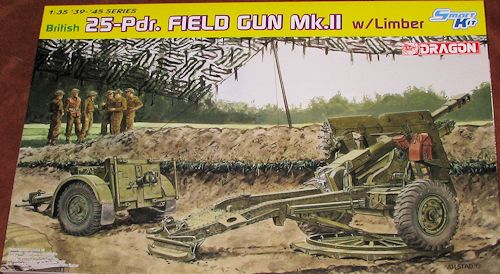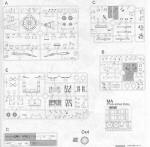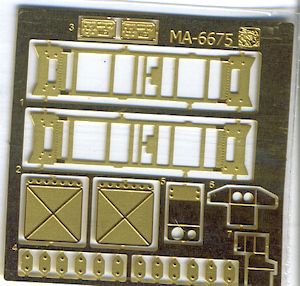
| KIT #: | 6774 |
| PRICE: | $49.00 SRP |
| DECALS: | None required |
| REVIEWER: | Scott Van Aken |
| NOTES: | Smart Kit |

| HISTORY |
The design was the result of extended studies looking to replace the 18 pounder (3.3 inches (84 mm) bore) field gun and the 4.5-inch howitzer (114.3 mm bore), which had been the main field artillery equipment during the First World War. The basic idea was to build one weapon with the direct-fire capability of the 18 pounder and the high-angle fire of the howitzer, firing a shell about half way between the two in size, around 3.5–4.0 inches (89–100 mm) of about 30 pounds (14 kg).
Development during the inter-war period was severely hampered by a lack of money and it was eventually decided to build a "new" design from existing 18 pounders by converting barrels but designing a new barrel and carriage for production when funds were available. The result was a 3.45 inches (87.6 mm) weapon firing a 25 pounds (11 kg). It was mounted on late model 18 pounder carriages. One of these used a circular firing platform and this was adopted for the new guns. The firing platform was lowered and the gun pulled onto it, providing a flat smooth surface for the road wheels that allowed the gunners to quickly traverse the weapon in any direction.Unlike the 18 pounder, the 25 pounder used howitzer type variable charge ammunition. For the Mk 1 Ordnance on 18 pounder carriage there were three "charges", Charge 1, 2 and 3 in a single cartridge. The 'proper' 25-pdr, Mk 2 Ordnance on Mk 1 Carriage, also had charge super in a separate cartridge. An increment for charge super was introduced in 1943 to provide higher velocity for anti-tank shot. Subsequently another type of increment was introduced to be added to charges 1 and 2 to provide three additional charge combinations for use with upper register (high angle) fire. The introduction of the increment to charge super was only possible following the addition of the muzzle-brake in the previous year.The 25-pdr was separate loading, the shell was loaded and rammed then the cartridge in its brass case was loaded and the breech closed. In British terminology the 25 pounder was called "Quick Firing" (QF) because the cartridge case provided obturation (it provided the gas seal in the breech) and was automatically released when the breech was opened.
In common with all British guns of the period the indirect fire sight was 'calibrating'. This meant that the range, not elevation angle was set on the sight. The sight compensated for the difference in the gun's muzzle velocities from standard. The gun was also fitted with a direct fire telescope for use with armour piercing shot. It also used 'one-man laying' in accordance with normal British practice.
An important part of the gun was the ammunition limber ("Trailer, Artillery, No 27"). The gun was hitched to it and the trailer hitched to the tractor when on tow. The gun did not need a limber and could be hooked directly to a tractor. The trailer provided the brakes as only a hand brake was fitted to the gun carriage The trailer carried ammunition; thirty-two rounds in trays (two rounds per tray) in the trailer protected by two doors. Ammunition was also carried in the gun tractor with the detachment and various gun stores. Some stores, such as sights, were carried cased on the gun. Each section (two guns) had a third tractor that carried ammunition and towed two ammunition trailers.
The gun detachment comprised the following: No 1 - detachment commander (a sergeant), No 2 - operated the breech and rammed the shell, No 3 - layer, No 4 - loader, No 5 - ammunition, No 6 - ammunition, normally the 'coverer' - second in command and responsible for ammunition preparation and operating the fuze indicator.
The official 'reduced detachment' was 4 men.
Many different Companies manufactured the guns and component parts in the UK. Vickers Armstrong in Scotswood, Baker Perkins in Peterborough and Weirs in Glasgow were some of the most significant. The various Royal Ordnance factories produced most of the ordnance components. In Canada Sorel Industries built complete guns and provided the ordnance for fitting to the Sexton. Australia also built complete guns, choosing to weld the carriages rather than rivet, as was the practice in the UK and Canada. In all, over 13,000 were made world wide. The gun remained in wide use by several nations until well after the war, some not retiring them until the 1990s and some still having them in store in case of need.
| THE KIT |
 Dragon's earlier kit of the Mk.I was well received so it was determined that the Mk.II would be equally successful. There are not many differenced between this and the earlier version of the gun, mainly in the shield and the gun cradle. The kit can be built with the breech open or closed and can also be built in either
Dragon's earlier kit of the Mk.I was well received so it was determined that the Mk.II would be equally successful. There are not many differenced between this and the earlier version of the gun, mainly in the shield and the gun cradle. The kit can be built with the breech open or closed and can also be built in either the towing or firing position. There are also optional tow hooks, lower shields, and the ability to have the limber doors open or closed. A nice photo etch fret is included, most of which goes on the limber. Here are all the details from Dragon:
the towing or firing position. There are also optional tow hooks, lower shields, and the ability to have the limber doors open or closed. A nice photo etch fret is included, most of which goes on the limber. Here are all the details from Dragon:
- Newly tooled gun barrel with hollow muzzle
- Newly designed side plates molded on field gun
- Includes tool boxes on gun trails
- Authentically detailed circular gun platform
- Optional firing or transport modes can be selected
- Detailed limber doors can be assembled open/closed with provision for opened ammo trays
- Optionally detailed tow hooks
- Gun cradle and hand wheels with well-defined details
- Name plates molded on side of gun trail
- Beautifully detailed slide-molded gun trails
- Crisp rivet details incorporated
- Components allow gun to elevate
- Moveable breech mechanism
- Gun can be set in full/partial recoil position
- Optional gun mountings included
- Gun shield molded with rivet detail
- Separate tools are fully reproduced
- Nuts sharply represented on road wheels
- Tires made from DS
Instructions are well drawn and really quite busy so one needs to pay attention when building. There are no decals and one can paint this for use in the desert or on the continent.
| CONCLUSIONS |
Those who like the 'queen of battle' will be very pleased with this one. Though it has been kitted by other companies, this one looks to be the best of the batch by far.
| REFERENCES |
http://en.wikipedia.org/wiki/Ordnance_QF_25_pounder
May 2013
Thanks towww.dragonmodelsusa.com for the preview kit. You can get this one today at your local retailer.
If you would like your product reviewed fairly and fairly quickly, please contactthe editor or see other details in the